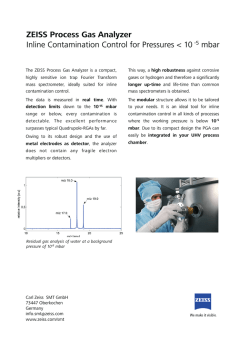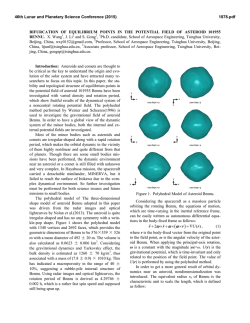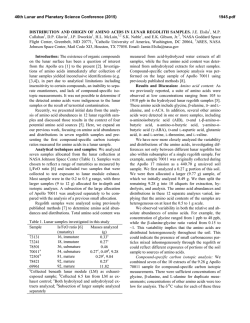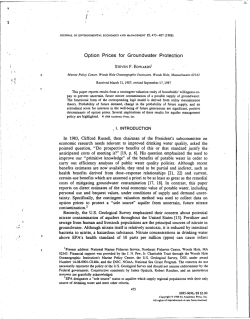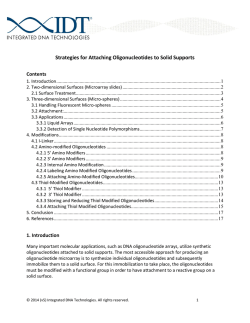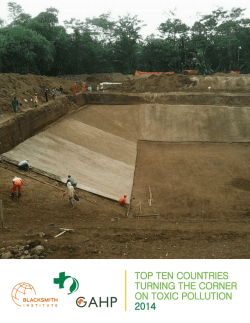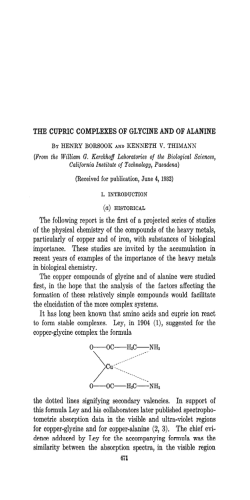
OSIRIS-REx IS A PATHFINDER FOR CONTAMINATION CONTROL
46th Lunar and Planetary Science Conference (2015) 1147.pdf OSIRIS-REx IS A PATHFINDER FOR CONTAMINATION CONTROL FOR COST CONTROLLED MISSIONS IN THE 21ST CENTURY. J.P. Dworkin1*, L. Adelman1, T.M. Ajluni1, A.V. Andronikov2, A.E. Bartels1, D.M. Ballou3, E. Beshore2, E.B. Bierhaus4, W.V. Boynton2, J.R. Brucato5, A.S. Burton6, M.P. Callahan1, B.C. Clark7, H.C. Connolly Jr. 8, J.E. Elsila1, H. L. Enos2, D.F. Everett1, I.A. Franchi9, J.S. Fust3, J.E. Hendershot1, D.P. Glavin1, J.W. Harris4, A.R. Hildebrand10, G. Jayne1, R.W. Jenkens1, R.M. Kuhns4, D.S. Lauretta2, J.V. Ladewig4, C.C. Lorentson1, J.R. Marshall11, L.L. Matthias12, S.R. Messenger6, R.G. Mink1, J. Moore4, K. NakamuraMessenger6, J.A. Nuth III1, C.A. Reigle4, K.E. Righter6, B. Rizk2, W.D. Roher1, J.F. Russell4, S.A. Sandford13, M.F. Sovinski1, J.M. Vellinga4,14 and M.S. Walker1 1NASA GSFC, 2University of Arizona, 3United Launch Alliance, 4 Lockheed Martin, 5INAF, 6NASA JSC, 7SSI, 8CUNY/AMNH, 9Open University, 10University of Calgary, 11SETI Institute, 12NASA KSC, 13NASA ARC, 14Retired, *[email protected] OSIRIS-REx: The OSIRIS-REx mission (Origins, Spectral Interpretation, Resource Identification, and Security Regolith Explorer) is the third NASA New Frontiers mission. It is scheduled for launch in 2016. The primary objective of the mission is to return at least 60 g of “pristine” material from the B-type nearEarth asteroid (101955) Bennu is spectrally similar to CI or CM meteorites [1]. The study of these samples will advance our understanding of the origin and evolution of primitive bodies in the solar system. The spacecraft will rendezvous with Bennu in 2018 and spend at least a year characterizing the asteroid before executing a touch and go maneuver to recover a sample of regolith. The sample will be returned to Earth in 2023. Defining Pristine: The OSIRIS-REx mission has a level 1 requirement to return the regolith sample in a “pristine” state. In the strictest sense, the “pristine” state is violated by any alteration of the physical, chemical, textural, or other state that compromises sample integrity. Alteration includes changing inherent states, losing sample components, or adding extraneous components. These could include changes in bulk chemistry/mineralogy, trace components, stable isotopic ratios, volatiles (ices, organics), crystallinity and phase state, remnant magnetism, grain-size distribution, grain/clast integrity, texture/structure/layering, and chemical/electronic activation state. As such, contamination of the sample can occur at any time in the lifecycle of a mission, and mitigation therefore needs to be carefully planned from conception. It is onerous to eliminate contamination in all of these areas simultaneously. A lesson from the Stardust mission [2] was to agree upon what is meant by “pristine”. We define pristine to mean that no foreign material was introduced to the sample at an amount which hampers our ability to analyze the chemistry and mineralogy of the sample. Specific contaminant abundances are set to achieve the NRC recommended “±30 percent precision and accuracy” [3] on measurements. OSIRIS-REx will focus on both the chemistry and mineralogy of the sample, so contamination control must simultaneously preserve the organic and inorganic compositions. Achieving this in a cost-controlled environment is a significant challenge. However, adequate knowledge of the nature of low levels of contaminants can effectively mitigate the impact of the contamination, depending on the analysis. Contamination Control: Based on our definition of pristine, we derived level-2 requirements for contamination control that were 1) traceable to an independent document or analysis, 2) achievable in the project budget and schedule, and 3) rapidly verifiable without impacting the critical path during Assembly, Test, and Launch Operations (ATLO). Since verification is performed on a surface, the contamination level in the sample must be converted to a surface area requirement. For maximum conservatism, we assumed 100% transfer of contamination to the minimum mass of sample. While this is certainly an overestimate, without a high-fidelity physical and chemical model of the surface of Bennu the transfer of a given compound class cannot be determined. Initially we looked to the Mars Organic Contaminants Science Steering Group (OCSSG) [4] for organic contamination requirements (Table 1) but found that the existing cleanrooms to be used for ATLO were insufficient to meet these requirements and that chemical analyses to verify the requirementscould not be routinely performed. Other benchmarks were evaluated, including analogous meteorites. However, the range of plausible meteorite organic abundances in Bennu analogs vary by orders of magnitude. Ultimately, the only class of molecular contaminants to be controlled are amino acids. These not only have a special interest for astrobiology, but serve as a proxy for all biological contamination. The specific limit of 180 ng/cm2 was derived from the total amino acid levels measured on Stardust collector foils [6]. To evaluate the transfer efficiency of amino acids, we coated an uncleaned engineering unit of the sampling mechanism with 530 ng/cm2 of the terrestrially rare amino acid D-isovaline. The sampler was sealed with 15g silica fume and 45g Cu-clad steel balls which had been pyrolyzed in air overnight at 700°C. The sampler was shaken for 1 minute at 5g and 20 Hz to 46th Lunar and Planetary Science Conference (2015) simulate the sampling and Earth return shocks. Amino acids were extracted from the fume and balls and isovaline abundances determined via standard analytical methods [5,6]. This test showed a worst-case transfer of 30 pg/g of isovaline, indicating a dry transfer efficiency of 1 part in 2 million, thought other less polar species may be more readily transferred. Regardless, 100% transfer efficiency is still used as a worstcase. Table 1. Organic contamination control limits evaluated for OSIRIS-REx. OCSSG [4] Aromatic Carbonyls & hydroxyls Amino acids Amines or amides Aliphatic hydrocarbons DNA Total reduced carbon ng/g sample 8 10 1 2 8 1 40 ng/cm2 sampler 0.25 0.31 0.031 0.063 0.25 0.031 1.3 OCSSG Level 2 cleaning guidelines [4] N/A N/A 10 NRC-derived (30%)[3] All detectable species ≤30 ≤0.94 Total carbon Amino acids 0.1% 70 31000 2.2 Total carbon Amino acids 32000 21000 1000 660 Amino acids N/A 180 Name Species 30% Worst-case meteorite (Y-980115) [5] 30% Reasonable meteorite (Murchison) [6] Stardust achieved [7] Viability Traceable Y Achievable N Verifiable N Traceable ~ Achievable Y Verifiable N Traceable Y Achievable ND Verifiable N Traceable ~ Achievable N Verifiable N Traceable ~ Achievable Y Verifiable Y Traceable Y Achievable Y Verifiable Y ND: Not determined; ~ external traceability is arguable. The use of meteorite analogs for total carbon and inorganic contamination limits was more straightforward, with conservative limits based on 10% of chondritic abundances (Table 2). To make these requirements useful, these limits were converted to the language of contamination engineering, based on films and particles described in IEST-STD-CC1246D [ref]. The species in Table 2 are captured under expected conditions, where contamination is dominated by organics and the majority of the inorganic contaminants will occur as particles. With these assumptions, a theoretical worst case with pure elemental particles is generally met by an achievable Level 100 requirement and a non-volatile residue level of A/2 for the sensitive areas of the OSIRIS-REx flight system. Table 2. Contamination control limits for OSIRIS-REx. Species Amino acids Hydrazine C K Ni Sn Nd Pb Purpose Proxy for biology, special interest for astrobiology Reducing agent Organics Lithophile Siderophile Industrial contaminant Lanthanide lithophile Chalcophile, special interest for chronology Contamination Limit (ng/cm2) Level 100 (particles) + A/2 (film) (ng/cm2) 180 180 1000 170 34000 0.53 1.5 180 34 + 500 14 + 500 143 + 500 117 + 500 113 + 500 182 + 500 Thus, all contamination control requirements were condensed to a 180 ng/cm2 amino acid requirement, 1147.pdf IEST-STD-CC1246D 100A/2 requirement, and a spacecraft and operations design to limit free hydrazine deposited on the sampler to 180 ng/cm2 (which is a powerful reducing agent and thus can destory organics). Contamination Knowledge: These requirements are necessary, but insufficient to permit sample analysis at the required level of precision. The 100A/2 contamination limit does not account for the presence of unexpected species nor does it provide information on the nature of acceptable contamination levels. Thus, in addition to samples collected during ATLO for particles, films, and amino acids there are witnesses deployed for contamination knowledge. A fraction of these samples are archived to be inspected in parallel with samples; the rest are analyzed by the science team every two months during ATLO to provide relatively prompt information on the contamination environment of the spacecraft assembly facility. This approach also protects the ATLO schedule from the scientific investigation of the contamination. Similarly, an array of sapphire and Al witness plates are flown on the spacecraft and exposed both before and after sampling. These plates are then returned with the samples for analysis to understand the contamination acquired during flight. To ease the interpretation of all these samples, selected sample return capsule materials, purge filters and gloves that are likely sources of contamination are also archived and will be distributed for analysis in parallel with samples of Bennu, as needed. Finally, samples of flight monopropellant, N2 used for sample collection, and cleanroom air samples are collected and analyzed by the science team shortly after launch. Additional Lessons: With OSIRIS-REx launching in 2016, it is important to realize that initial thoughts on contamination control were formed in 2004 and matured via weekly input from both scientists, engineers, and managers from across the Project since 2010. The authority to implement these requirements derives from sample cleanliness being a Level-1 requirement. Simplicity and cost control derives from the presence of a graceful descope plan for cost growth avoidance. It is crucial that the same people who wrote the mission concept and requirements are the ones who implement the cleaning and analysis. References: [1] Clark et al. (2011) Icarus 216, 462-475. [2] Sandford et al., (2010) Met. Planet. Sci., 45, 406-433. [3] NRC (2007) Task Group on Organic Environments in the Solar System., p118. [4] Mahaffy et al. (2004) http://mepag.jpl.nasa.gov/ [5] Burton et al. (2014) Polar Science 8, 255–263. [6] Glavin et al. (2006) Met. Plan. Sci., 41, 889-902. [7] Elsila et al. (2009) Met. Planet. Sci 44, 1323-1330.
© Copyright 2024

